
Running a Membership Program: Four Years In
Everything I've learned in the first four years of running SPECIAL PROJECTS
I kept trying to write this Year Four review of my SPECIAL PROJECTS membership program, and life kept getting in the way. But it was life born from and nurtured by SPECIAL PROJECTS. It’s almost as if the program itself had barged in and said: Look, bud, I know you want to reflect on the last year, but we got stuff to do. This makes me happy, the program getting in the way of the program. So here I am, pushing back against all that stuff — good stuff, exciting stuff, creative stuff, book stuff — to look back, because looking back is valuable (not just to me, but to those of you out there looking to do similar things). So here we go, a month late, but better late than never.
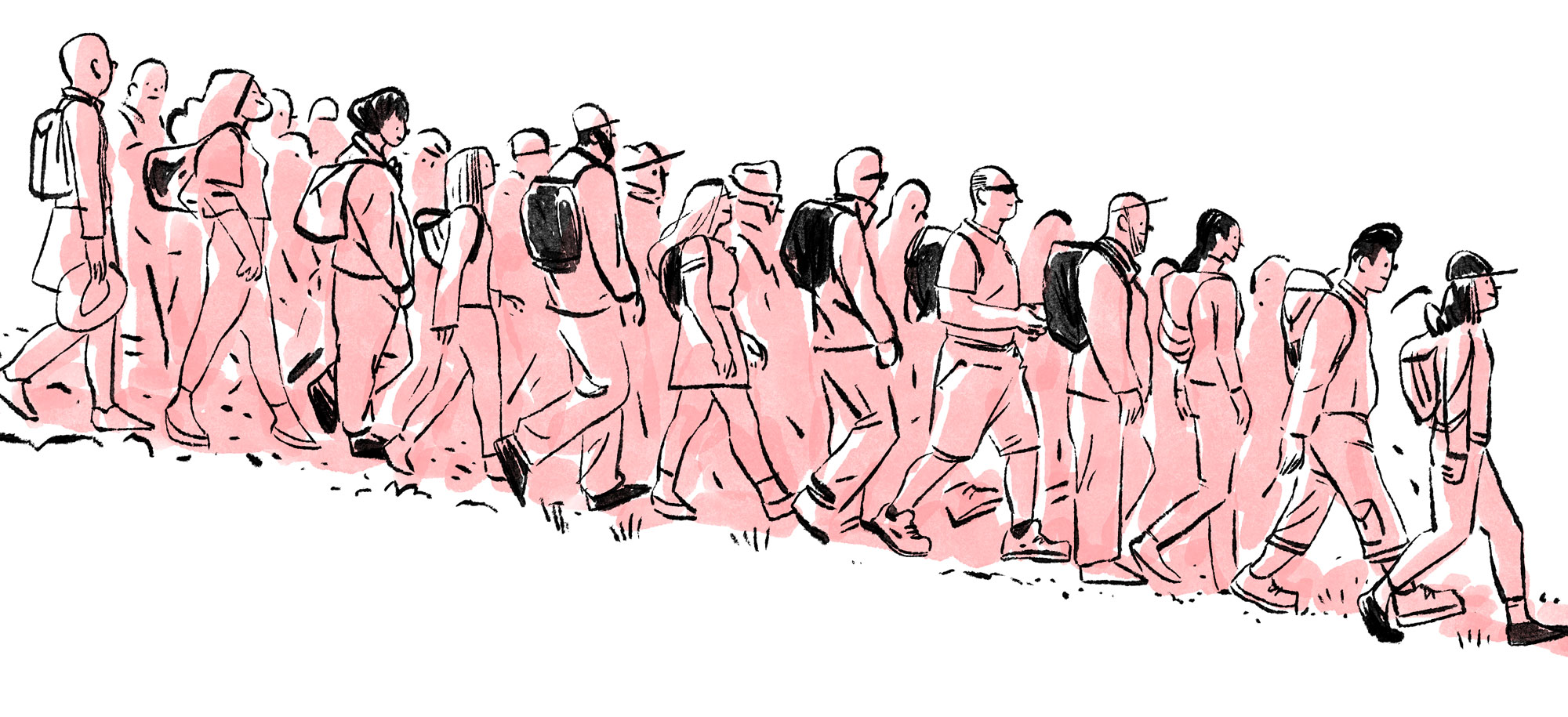
Contents
#Introduction
I started SPECIAL PROJECTS some four years ago now. That feels like several lifetimes back. We had yet to meet Covid-19, the world had yet to experience the violent heaving of 2020, 2021, and 2022. The public markets had yet to halve themselves (and recover slightly). If you take away only one thing, take away this: Four years is a long time, and four committed and focused years can yield a tremendous portfolio of work.
If you’re thinking about running a membership program, you’re probably a bit wacky. Everything I write about membership programs should be filtered through the lens that: I live a somewhat uncommon, sometimes extremely wacky life. It’s good to keep that in mind. My work is mostly, inherently, non-commercial. Or less commercial than it might be “optimized” for. When people ask me: Who are you? What do you do? And I tell them — I walk, I write, I photograph, I make books, I run a membership program. Their suspicion is plainly visible: No, but what do you do to survive? As if the soul itself wasn’t a thing to be nourished. This is survival, I want to say. But instead I say: And from those activities I make several hundred-thousand dollars a year. That changes the tenor quickly. Cashflow, sadly, validates. And if even further validation is necessary I can say: Sometimes I, uh, write for The New York Times. Game over. I’m now a “real” person grounded in their universe. It’s easy to forget how much cultural sway that single media entity holds over the minds of everyone around the world.
Which is all to say: If you run a membership program, and do so full time, with total gusto, folks will look at you askance. And you will need to shore up your internal mechanisms for letting askance-ness bounce off (easier said than done).
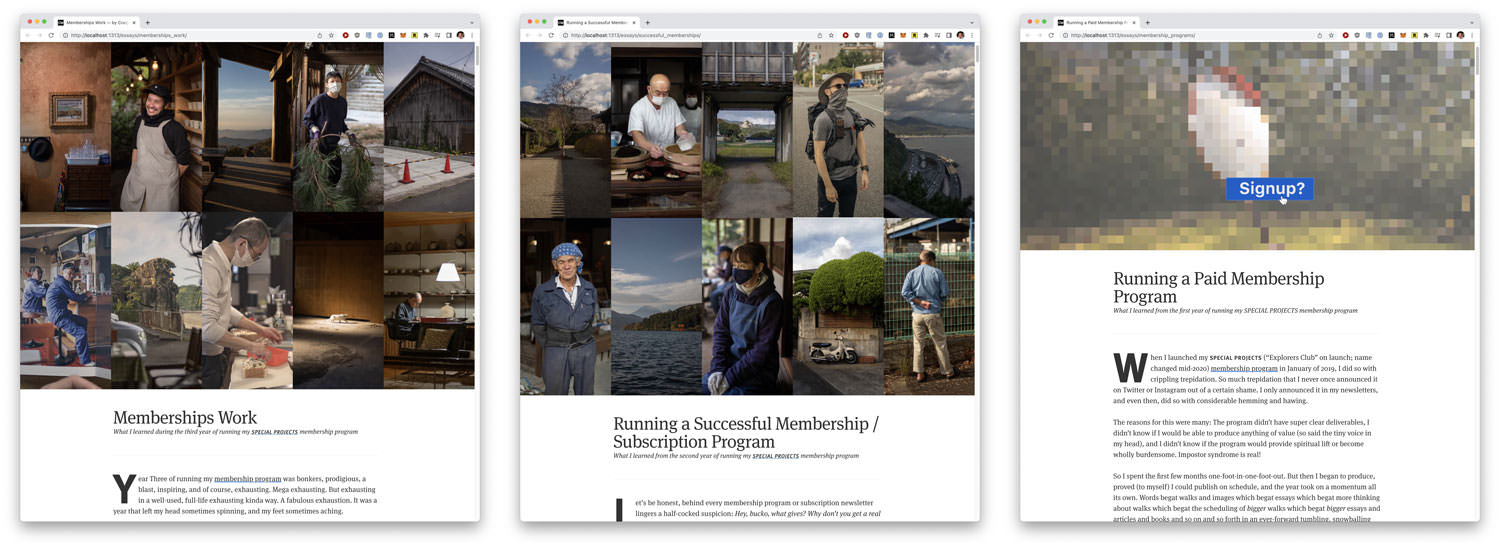
#Lookback Through The Years
Much of what I’ve learned over the last four years has been written up in previous reports:
- Year 1 (2019): Running a Paid Membership Program (5k words)
- Year 2 (2020): Running a Successful Membership Program (8k words)
- Year 3 (2021): Memberships Work (9k words)
I’ve written some 22,000+ words about membership programs. Most everything that can be covered is covered in those previous writeups. You’re welcome to read them all, but I thought it might be helpful to look back through the highlights:

#Launch essay (published Jan 2019):
I launched the program in my Roden newsletter in late January 2019 (it was called Explorers(’?) Club back then). And I did so almost as if I was hiding in a closet, whispering out to my audience:
I don’t start this membership program lightly, and I do it with all the fear and trepidation you’d expect of someone who isn’t a psychopath, who respects their audience, is generally self aware, who treats these sorts of asks like handling plutonium in a paper sack.
Context: I had been trying to sell various essays to various publications, and had failed to do so. And I had failed to sell a book. And I was feeling despondent and, quite frankly, a little bit bummed out on the whole. In a throw me a bone, man, kind of way. I was working hard and it felt like I was in a ditch and had no footholds to get out. I flew to New York looking for a job, I met with editors. I thought about leaving Japan and going in-house somewhere to “learn” what it took to write for a bigger audience. Friends in the industry said, Look, you’re where we want to be. You have an audience. You know what you want to write about. Can’t you leverage that?.
I had just written about membership software for WIRED a few months prior. I had lectured about memberships at the Yale Publishing Course the previous summer. It was on my mind. I started planning, launched a couple months later, and felt immediately like a failure. Which I wrote about in the Year One review:

#Year One (2019) Lookback (published Jan 2020):
Year One key points:
- extreme trepidation
- many unknowns
- leaning into the “formalization of work” gained from memberships
- screwed up launch? sort of
- interesting to look back on how fearful I was — important to not forget this
On the depression / coyness of the opening shot:
So I spent the first few months one-foot-in-one-foot-out. But then I began to produce, proved (to myself) I could publish on schedule, and the year took on a momentum all its own. Words begat walks and images which begat essays which begat more thinking about walks which begat the scheduling of bigger walks which begat bigger essays and articles and books and so on and so forth in an ever-forward tumbling, snowballing way.
And from this, perhaps the most important element of the membership program came to be:
But the membership program created a formality and from that formality I divined a permission — both financially and spiritually (my members are incredibly supportive) — to work deeply on topics I find interesting and important.
2019 ended up being incredibly generative.
The timing of the launch was somewhat fortuitous. I had the wind of that first year in my sails as the pandemic hit in 2020. As the world shut down, I was able to lean hard into the “formal permissions” of the program. Travel stopped and I found myself alone, at home. I did what I knew best: I made a book, and tried to share as much of that process with the members as I could:
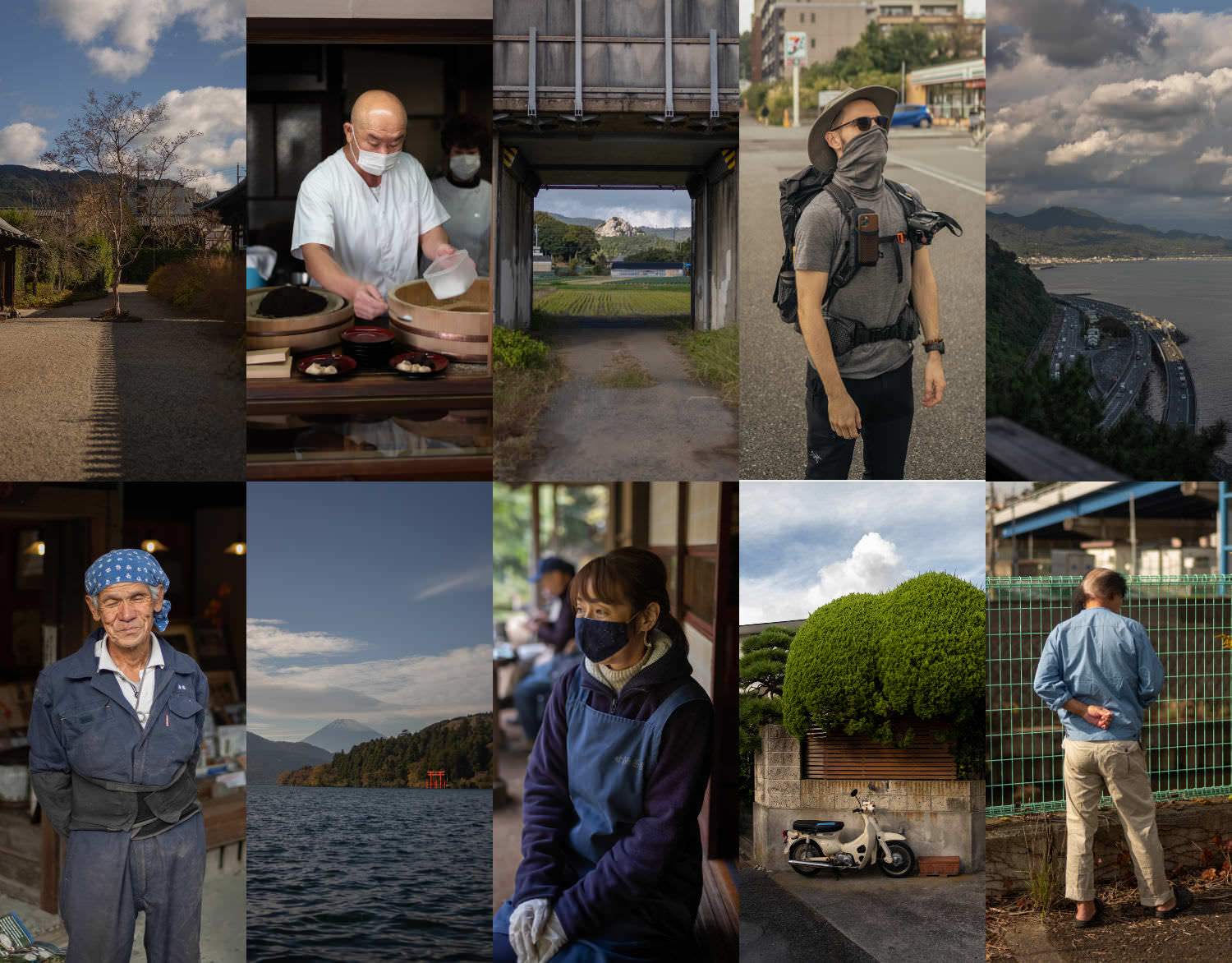
#Year Two (2020) Lookback (published Jan 2021):
Year two key points:
- making things is, in a way, the only thing
- making Kissa by Kissa
- leaning into video work
- livestreams
- starting to play with documentaries
- on-the-road “boring” vignettes
- Office Hours podcast
Year two was when things went into so-called “hyperdrive.” Kissa by Kissa came out in August and reconfigured my entire financial and creative world. It validated my intuition of audience into tangible audience. We sold thousands of books and memberships. From the start of the program to finding this massive “product-market fit” took eighteen months.
Noting the unique position I now found myself in:
I harbor no illusions — it’s unlikely for a magazine or publisher to bankroll a thirty-day walk from Tokyo to Kyoto along an old highway, chatting up nearly-dead barbers and looking to place 200-year-old woodblock prints by Hiroshige in conversation with the road of today. Sure, you can cover a small bit of the walk with a magazine commission, but to take the bigger risk of months of research, action, and follow up, you need a more durable foundation. This is where membership programs soar — they are implicit and durable permission machines.
Permission permission permission. I see a theme developing.
Implicit in that the support itself is a signal, and durable in that those signals are “distributed.” Permission via members is an assemblage of diffuse permissions, indie permissions, not a kingmaker bestowing some canonical singular permission. Creatively, I find this arrangement freeing. In praxis it has led to bigger, more audacious and ambitious projects than I would have attempted on my own.
On formalization:
I find that by “formalizing” a newsletter, for example, I write more and better newsletters. By “formalizing” a walk, I walk with a sharper eye, open to more finely-grained details, with a greater empathy for those I meet along the road, and with an ever-stronger impulse to transmute those encounters into something much larger than the moment itself.
Business insight:
The biggest insight I had in 2020 was a banal but powerful one: Digital memberships and physical things make for superb bedmates.
Don’t do physical just for members:
I highly recommend not making things just for members. Instead, make something (a book, a print, a poster, a documentary, a whatever) that you would have made no matter what, and offer it up to members at a significant discount.
As SPECIAL PROJECTS grew, I became increasingly aware of the itch to do more “meta” stuff just for member. BUT, I wanted to avoid that. I didn’t want to become “beholden” to program “deliverables:”
You start a membership program with certain goals in mind — producing a book or film or writing a newsletter for example — but because the program is successful, you twist yourself to be entirely membership focused. You’ve gone from being an artist to someone who “does” a membership program, which often involves a dominant meta-component of how to successfully run one. Which can be good or bad depending on your aims.
Thankfully, I framed membership in a way that largely mitigated members “demanding” more. They knew what they were getting (I try to be brutally honest) and were OK with that.
In spite of the pandemic, Year Two was financially and spiritually one of the best years of my life. And that’s in no small part thanks to SPECIAL PROJECTS.
Onward, to Year Three:
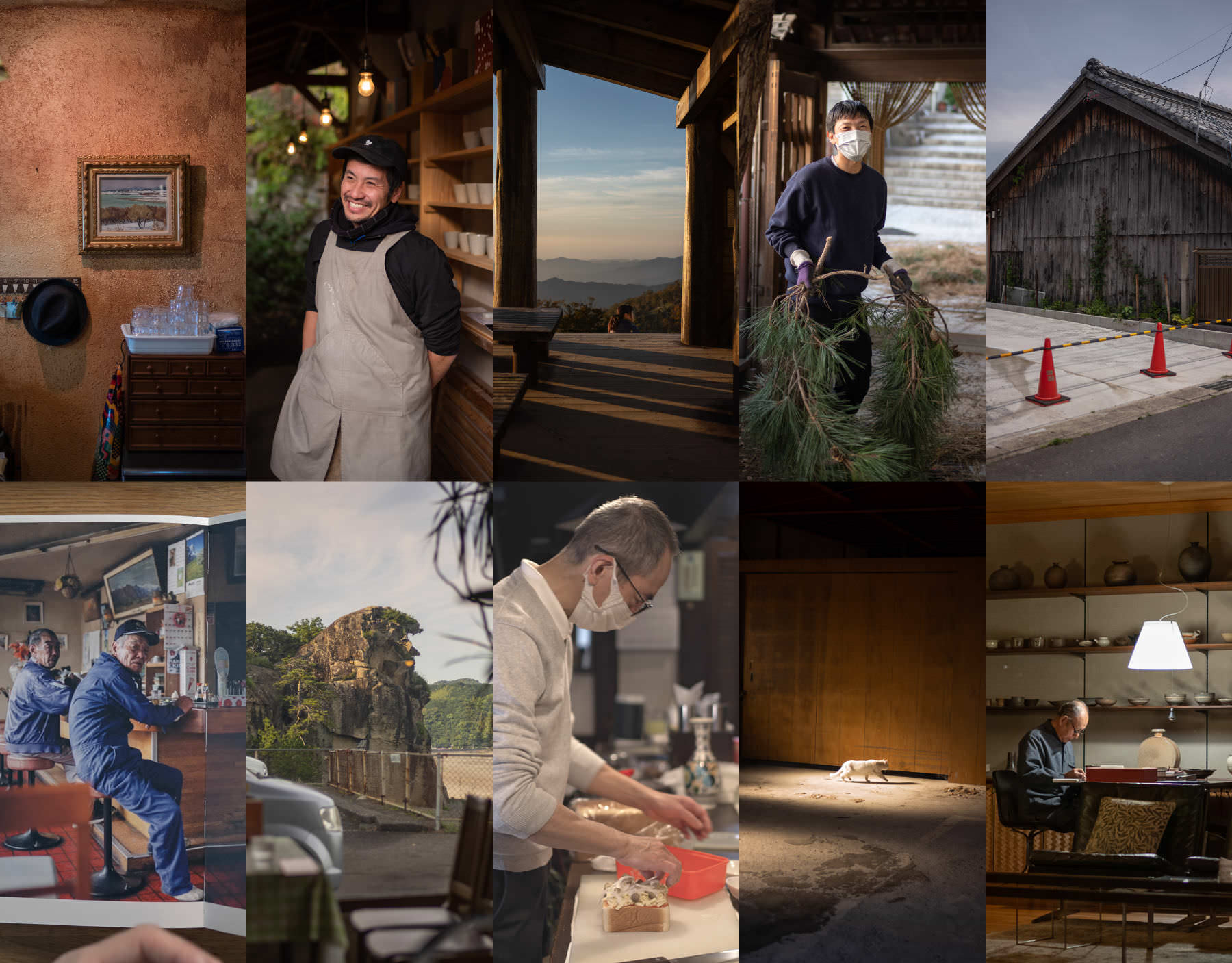
#Year Three (2021) Lookback (published Jan 2022):
Year Three key points:
- a year of refinement
- hiring a studio manager
- moving to a big distribution center
- switching printers
- Pizza Toast & Coffee short film
- The Craft of Kissa by Kissa documentary
Years passed. The more I committed to SPECIAL PROJECTS, the more inspiring became the folks I found myself in contact with:
Committing to big, messy, creative projects is a reliable way to increase the number and quality of healthy, talented archetypes within your orbit. The highest signal you can send a busy, accomplished person is that you are someone who makes, not just talks.
SPECIAL PROJECTS was causing me to make, and make in heaps.
The stagnancy I found myself in back before the start of launching the program (trying to get essays and books published, failing to do so), was in part, I now see, a lack of producing.1 I was working hard, but a lot of that work was a kind of churning, not a forward moving work. That is, I was sitting with the same essays, the same chapters of books for years. SPECIAL PROJECTS — by unlocking the permission to go on larger adventures, with more formality — generated incredible forward momentum. A momentum that led to more words written, more books made, more things produced in three years than the entirety of my life up to that point. In a way, it was a bit depressing. If only I had started doing this earlier!
On all that:
Fundamentally, what I really needed was much simpler: to write more, with more urgency, looser, with fewer boundaries, and much less preciousness.
It sounds silly, but that small exchange of cash back in 2019 — between me and a few hundred people, a formalizing of some unwritten contract with members — was all it took to flip a switch in my mind, to go from relying entirely on self-driven motivation to feeling the (useful!) pull of Hired Writer. Suddenly, a walk was no longer a navel-gazing stroll, it was a job with curious rules and exigency. My members were members because they wanted to “support” my writing, and that was all I needed to get More Butt into More Chair and do more work with more formal rigor than I had ever done before.
The results are present not only in volume, but also quality. Sure, these past three years I’ve written tons, but within that tonnage is some of the best writing of my life.
Year Three was also when the arc of product-market fit could be seen with a bit more clarity:
- 2019:
MVP , just ship something, anything, goddamnit, you fool, get it out there, see if there’s a modicum of interest / market - 2020: Iterate until we find product-market fit; and boy did we find pretty good product market fit (Books + Memberships)
- 2021: Hire a competent and creative assistant, a new accounting firm, move our physical books & prints to a proper warehouse and fulfillment center, collaborate with an even higher-quality printer; effectively “refactor” the “codebase” and infrastructure of the membership program
I was also able to distill the essence of it all to a single sentence:
The purpose of SP is to enable a continuous and rigorous production of book-shaped projects until I’m dead.
During Year Three we also began to see the effects of SP spilling out into the real world. I went back to check in on Shimane-san — the protagonist of our Pizza Toast & Coffee short film. He said, “I thought the footage was useless, that you didn’t make anything.” No, no, I told him, we made something, and it’s been seen by tens of thousands of people. I played it for him and scrolled through the comments. He was in disbelief, teared up, shot videos of my laptop screen to show to his sister.
In the Year Three Lookback, I also established some tips for not losing your mind while running programs like this. They’re all good enough to quote in full:
-
Never look at subscription data more than once a quarter. And even then, don’t really look at it. Glance timidly and not for long. SP crested a line in 2020 that I define as the “enough” line. Everything above that line is Good. I ambiently “see” the line when I send out members-only emails because my newsletter software tells me how many recipients are out there, but I try to never gaze directly into the beating heart of those digits. Books and education are the goals, not eternal, mythic GDP-style growth of membership revenue.
-
Don’t get notified when anyone unsubscribes from anything. I can’t believe some newsletter / membership software DEFAULTS — d e f a u l t s — to emailing you when someone unsubscribes or cancels a membership. are. you. mad? Who are these Sadist Engineers of the Fifth Circle of Hell setting these defaults? The quickest route to declining mental health is to open yourself up to this attack vector. Close it down and keep it shut. Members leave for all sorts of reasons, and “you suck and are a dumb dumb and I hate you” is almost certainly not the (main?) one. (Though it is the one your mind will scream at you upon arrival of each unsubscribe email.)
-
Don’t “bend” yourself or your membership program to the assumed “needs” of members. That is, be clear in what you want to achieve, and communicate those goals directly, upfront. Members will self-select in support of those goals and you won’t feel the need to generate a “Second Self” to somehow placate members who joined for the wrong reason.
Year Three also saw me understand with more clarity my “role” in the eyes of members and the role members hold for me.
On “hiring” members:
I’ve been mainly “hiring” members for permission. Not in a “please allow me to do this” kind of way, but more a “formal contract” kind of way. It’s nice to “sign” something and make it official. I wish my intrinsic motivation was more reliable, but I’ve come to realize I thrive through clear accountability. (I suspect most of us do.)
Aligned with the above, I’m also hiring members to make the creative process less lonely. I hire them as “audience” members. The “Boring Livestreams” I run are mainly to get me to do “boring” work with greater intentionality. It turns out most creative work-work is “boring” work: iterative and circuitous. I also broadcast those livestreams because I believe there’s value in being able to look over the shoulder of someone as they perform the less glamorous acts of creativity.
And on the “vibes” of the whole thing, this still feels true:
Overall, three years in, the Members ⇄ Craig relationship feels extremely symbiotic. Like we’re all on a big, funky, pizza toast infused walk together. I’m divining a sustainable financial base, a set of permissions and support, and members are “hiring” an archetype, a guide, a mentor, to simply do the work that I feel I should be doing.
By the end of Year Three this all felt mildly “mature.” Intuitive, you could say, like the program had been in place for decades, not years, and my creative process and lifestyle had now aligned itself to the (somewhat boundless!) permissions and intimacy afforded by SPECIAL PROJECTS.
Year Four continued in the vein of refinement:

#Year Four (2022) Lookback (Published Now, March 2023)
Year Four key points:
- continued refinement of program
- the power of mixing memberships with established media
- Kissa by Kissa 4th Edition
- keep dancing (keep writing, keep moving)
General overview of what was produced in Year Four:
- Pop-up Newsletters:
- Nytimes Kii piece
- Kissa by Kissa Japanese translation
- Two prints (Tomato Farmers, Cutter)
- Ridgeline — 24x
- Roden — 11x
- Nightingalingale (members-only book diary) — 98x
- Kissa by Kissa 4th edition
The biggest takeaway from Year Four was remembering how much power, influence, and eyeballs, a publication like The New York Times brings to the table. I published an essay + photos about the Kii Peninsula in April, 2022, in the Times’ “Through a Lens” series and the response was overwhelming. Within a couple days, we had processed well over twenty-thousand dollars in new memberships and book sales. This revealed a critical point: Having a functioning membership program up and running creates a kind of “interest net” for folks who find your work out in the wild. This allows you to meaningfully “capture” that attention (gosh, this sounds like terrible marketer speak, but you know what I mean), “convert” (ugh, sorry) them to members, supporters, owners of your books, etcetera. Without a membership program, the best you can hope for is someone finds your newsletter or Twitter account and subscribes. With a membership program, there is an opportunity for a more “formal” connection (catalyzed by cash exchange). This is good!
I suppose the above should be obvious, but much like how Kissa by Kissa’s symbiotic relationship to memberships was a surprise, so too was this Times experience. You can theorize until you’re blue in the face, but until you get out there, make things, and put them into the world, their empirical realness will never be entirely clear.
Otherwise, Year Four was the year I finally got Covid, endured a trying breakup with my longterm partner,2 but otherwise continued dancing ever-forward.
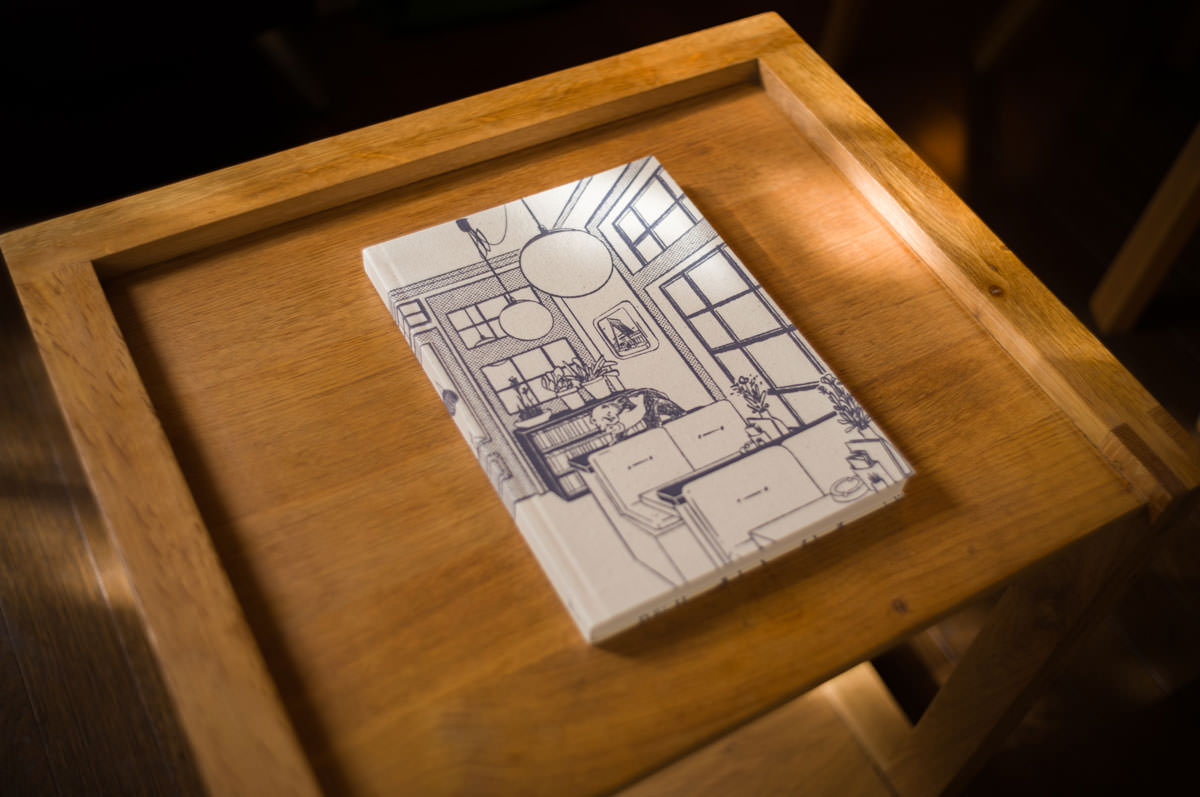
My TOKIO TŌKYŌ TOKYO pop-up newsletter + walk in August was the most popular newsletter I’ve written, by far. William Gibson even tweeted about it (I mean, c’mon, if anything is perfect Gibson catnip, it’s a “pop-up” newsletter called TOKIO TŌKYŌ TOKYO). Thanks to its popularity, we sold out of the remaining several hundred copies of Kissa by Kissa’s third edition. Thanks to that I had an excuse to make Kissa’s fourth edition — an edition I consider close to the platonic ideal I’ve had for the book: A beautifully illustrated (thank you Luis Mendo!), full-wrap silk-screened cover, precise thickness on cover boards for maximum Good Hand Feel, and general printing heavenliness. We also corrected what I believe to be the last few lingering errata.3
I continued to write my members-only Nightingalingale book-writing diary newsletter (98 issues!). A “process” newsletter in which I continued to document my refinements to Kissa by Kissa’s followup book. Hilariously, I started that newsletter in September 2021, thinking I’d have the book done by the end of that year. It’s now March 2023 and I’m amidst agent and editor pitches and still feel like I need to give the whole thing another good scrub. But, simultaneously, I’m more excited about this book than anything else I’ve ever produced.
So it goes, the years pass. Permissions divined, work is done, and the archive builds and builds.
Speaking of building up archives, the Member Benefits have increased steadily and organically. I think it’s instructive to look at this progression:
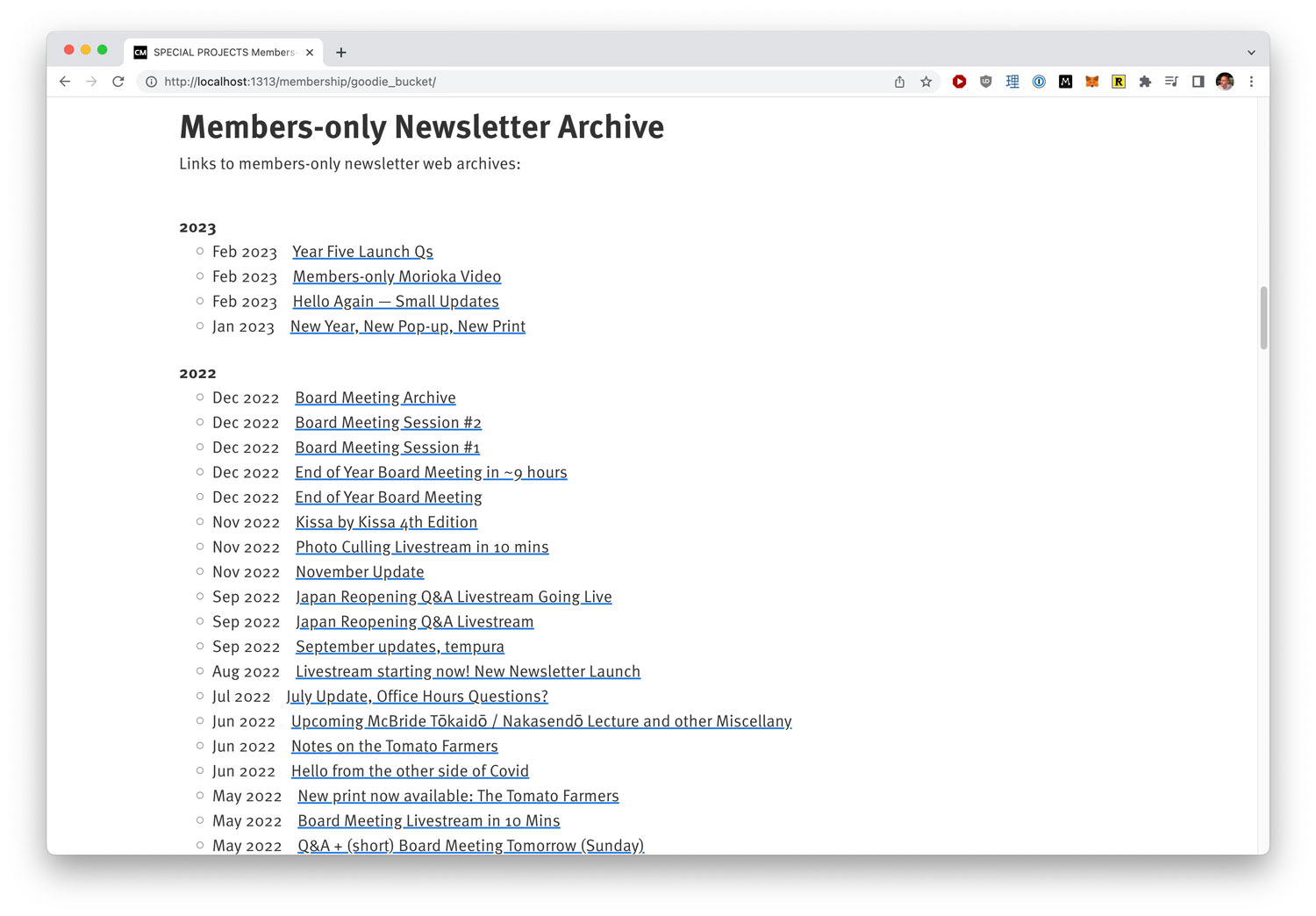
#Evolution of Membership “Benefits”
As I’ve said many times, the goal of SPECIAL PROJECTS isn’t explicitly to provide members-only benefits. All of my members-only livestreams or newsletters are done largely with education in mind — that is, to reveal some part of some creative process that would otherwise be too intimate to do at “normal” scale (i.e., to the tens of thousands of subs on my social media accounts or public mailing lists).
Still, it turns out that if you run enough members-only Livestreams, and archive enough Pop-up Newsletters, then the membership benefits increase handsomely over time. Here is a look back at how they’ve expanded over the years, organically in alignment with my work.
#Year One Benefits (2019):
- PDFs of Art Space Tokyo and Koya Bound
- Wallpapers
- A few random discounts on event and retreat tickets (totally unscalable and extremely limited but worth mentioning)
- Office Hours 1:1 chats (some even in person in San Francisco’s Sight Glass Coffee!)
- SPECIAL PROJECTS Newsletter (9 issues)
Over the years I’ve slowly increased the number of “benefits” to members. When I started I offered almost nothing! The whole value proposition of being a member was summed up by: “Craig, ya weird bird, I want to see more of your work in the world.” I — a dramatically underfunded NPR — am asking for your support. That was the rallying call. And it was not a great one. Signups that first year were OK but not exceptional. But, you know, shut up and get to work.
#Year Two Benefits (2020):
- Launch of members-only section of website
- PDFs of Art Space Tokyo and Koya Bound
- Wallpapers
- “Pop-up walk” video archive (2 videos)
- SPECIAL PROJECTS Newsletter archives (50 issues)
- SMS Project archive (first “pop-up walk” newsletter)
- Pachinko Road pop-up newsletter archive
- Office Hours Podcast launch (4 episodes)
- A Most Boring Livestream archives (16 videos)
- Yearly Members: Kissa by Kissa discount
From Year Two, benefits started to make more sense. I added a members-only section to this website, which provided me with a “formal” bucket in which to put member goodies. Sometimes you need to make the room before you’ll know what to put in it.
That members-only section was simple: an .htpasswd file on a directory with a shared login for all members. I didn’t want technology to get in the way of my doing, and this was bar-none the simplest way to create a members’ space. (And is still how I do it today!)
I had done a “pop-up walk” at the end of Year One, so that video needed a place to live. I had started to run Office Hours group chats, and so had some recordings of those. That foray into “video content” led me to choose unlisted YouTube videos as the place for members-only videos. Again: Simplest possible technology choice. Video is data-heavy and expensive to host. YouTube does a great job for free. Unlisted videos are a good hack.4
The members-only newsletter (largely unnamed but sort of named Inside Explorers but really just mind-numbingly called SP Newsletter) also had nine issues from 2019 (I wrote 41 more in 2020), so we needed an archive for that. And I ran my first “big” pop-up newsletter, Pachinko Road — tracking my walk along the Tōkaidō — and it needed an archive.
Oh, and in Year Two, Kissa by Kissa launched which sort of changed everything. Yearly Members got big discounts. Those discounts were distributed via email. (Again, so I didn’t have to create a special “Yearly Members Only” section on the website. You can easily email subsets of subscribers based on plans; I also trigger these same emails on signup.)
I transitioned from office hours 1:1 chats (unsustainable, unscalable) to the Office Hours members-only podcast. This integrates seamlessly with Memberful, my membership program software. Each member gets a unique podcast URL to add to their podcast software of choice.
And, finally, I started livestreaming “boring” work sessions to members in 2020, so those video archives needed a home.
#Year Three Benefits (2021):
- Members-only website area
- PDFs of Art Space Tokyo and Koya Bound
- Wallpapers
- “Pop-up walk” video archive (2 videos)
- SPECIAL PROJECTS Newsletter archives (104 issues)
- SMS Project archive (first “pop-up walk” newsletter)
- Pachinko Road pop-up newsletter archive
- Where are all the Nightingales? pop-up newsletter archive
- Tiny Barber, Post Office pop-up newsletter archive
- Nightingalingale book-writing process diary, members-only newsletter archive (30 issues)
- Office Hours podcast archive (7 episodes)
- A Most Boring Livestream / members-only videos archives (45 videos)
- Yearly Members: Kissa by Kissa 3rd edition discount
- Yearly Members: Limited print discounts
Now the program had “legs.” We had a (basic but still completely fine) members-only section on the website offering up video and newsletter archives. And Yearly Members got emailed big discounts on books. Finally: Value Proposition beyond Weird Bird, Fly Thee Well.
Year Three saw expansion across all areas. I ran two big pop-up newsletters: Where are All the Nightingales? and Tiny Barber, Post Office. Both of which had serious audiences. Recorded three more Office Hours podcasts.
I also produced two short documentaries and ran several “boring” livestreams of working on those videos. Archives of all that behind-the-scenes video work lives in the members-only section.
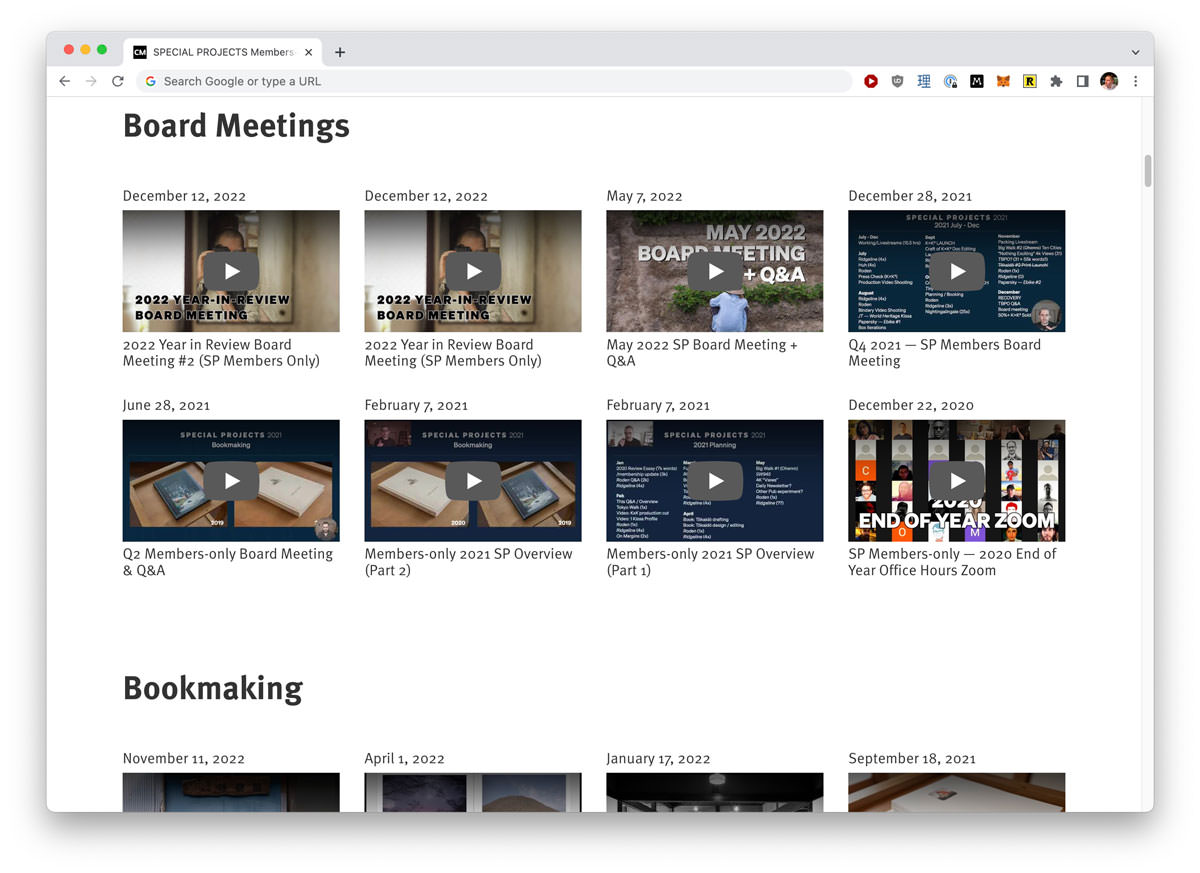
#Year 4 (2022):
- Members-only website area
- PDFs of Art Space Tokyo and Koya Bound
- Wallpapers
- “Pop-up walk” video archive (2 videos)
- SP Newsletter archives (136 issues)
- SMS Project archive (first “pop-up walk” newsletter)
- Pachinko Road pop-up newsletter archive
- Where are all the Nightingales? pop-up newsletter archive
- Tiny Barber, Post Office pop-up newsletter archive
- MIBAW pop-up newsletter archive
- TOKIO TŌKYŌ TOKYO (#1) pop-up newsletter archive
- KIIIIIIIIIIIIIII pop-up newsletter archive
- Nightingalingale book-writing process diary, members-only newsletter archive (100+ issues)
- Office Hours podcast archive (8 episodes)
- A Most Boring Livestream / members-only videos archives (57 videos, 95 hours total)
- Yearly Members: Kissa by Kissa 4th edition discount
- Yearly Members: Limited print discounts
Real growth! This is now an undeniably impressive amount of stuff for members. It’s important to note, though, that this is all in addition to writing Ridgeline and Roden and other entirely public-facing essays. And the pop-up newsletters themselves are also inherently public (anyone can subscribe). It’s only the archives I keep behind a members-only wall.5
It’s also worth noting, that I not doing any of these things because I feel like I “have to” for members. Everything here is an organic byproduct of working on books (the livestreams) or things to promote books (the short docs) or educational archives of things that were initially public.
I wrote about being terrified of turning into a meta-commentator about memberships at the end of year two. I think I’ve done a good job at avoiding this while still providing value to members.
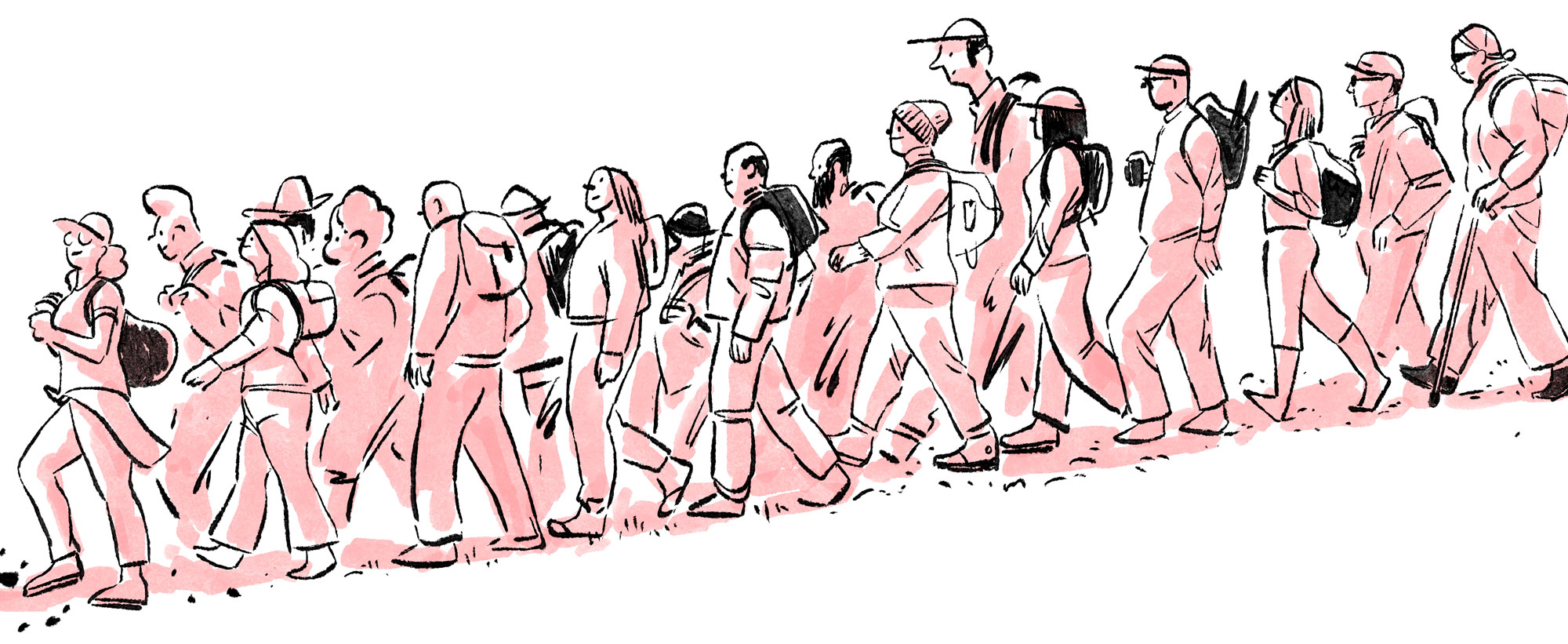
#Technical Stack / Running Costs
Not much has changed from last year’s tech stack side of things. The biggest shifts:
- Digital Ocean raised their prices a bit
- I’m now using Ecamm Live over OBS because I find the interface is a bit more refined 6
- I stopped paying for Zoom (feels invasive, badly engineered, low-quality?), and I do my members-only Board Meetings over YouTube with live chat, rather than in a Zoom meeting room. I do all personal video calls on Facetime or Google Meet (which has gotten surprisingly good and allows up to 100 people to join a call all but obviating Zoom’s paid value propositions)
- Also dropped MailMunch — it did convert folks to newsletters subscribers, but it felt clunky and somewhat evil and against the ethos of Good Things; the annoyance of a newsletter pop-over far outweighed the benefits
As for hosting video, YouTube is still the only cost-effective option (I mean, it’s free). But it also has the best streaming algorithms, best 4K options, and is quite flexible for livestreaming / chats / playbacks. It’s one of the best pieces of software Google makes. It integrates seamlessly with Ecamm Live. Anytime someone links to a self-hosted video or Vimeo video, I cringe hitting play — as the the streaming quality / buffering is often painful and clunky.
I’ve been using a “private” members-only Instagram account to do “behind the scenes” commentary or “pop-up walks.” I then aggregate those behind the scenes videos for each pop-up into an unlisted YouTube video. Instagram isn’t ideal, but it is — as far as I can tell — the easiest way to broadcast “semi-live” video updates to a private subset of viewers. Most people have accounts, those who don’t can watch the YouTube video posted soon afterwards.
On the backend, I’ve been building out my library of Python scripts to help create archives for the members-only section. Most of them are for generating pop-up Newsletter archives (using the Campaign Monitor API). But my latest addition is a script to pull unlisted video data from my YouTube account, parse categories, and generate a json file to be ingested by Hugo and produce a useful members-only Video Archive page. I use YouTube Lite to show all the video previews on a single page without it feeling slow / heavy.
As of February 2023, here are my membership-related software costs:
| Service | Cost/mo | Notes |
| Digital Ocean Server | $40.00 | Hosting for craigmod.com, specialprojects.jp, walkkumano.com, et al. |
| Cloudflare | $32.00 | Domain caching, protection, CDN |
| Backblaze backup + B2 storage | $30.00 | Backup for computer / video files |
| Dropbox | $30.00 | Backup / offline storage / file sharing |
| Memberful | $25.00 | Managing memberships themselves (tiers, signups, billing, refunds, et cetera) |
| Campaign Monitor | $300.00 | Running Ridgeline / Roden / SPECIAL PROJECTS newsletters, as well as all pop-up newsletters |
| Quicken | $5.00 | Boring but surprisingly good (!!) accounting software; excellent for generating expense / income reports |
| Libsyn | $5.00 | On Margins SW945, SP Members-only Podcast hosting |
| Simplecast | $15.00 | Office Hours & SW945 hosting |
| Descript | $12.00 | Podcast recording and editing |
| Shopify | $30.00 | Selling books / digital goods / hosting membership perks |
| Plausible | $8.00 | Privacy friendly web stats |
| Google Apps | $10.00 | craigmod.com, specialprojects.jp email |
| Ecamm Live | $30.00 | Livestream software |
| Moneytree | $3.00 | Japan accounting software |
| Experian | $19.00 | American credit extortionist racket payments |
| name.com Domain Name registrations | $50.00 | craigmod.com, specialprojects,jp, etc (the "etc" is doing a lot of work here) |
| TOTAL | ~$648.00 | monthly running costs |
Or about $7,500 / year in recurring software costs.7
Overall, it’s a fine technical stack. I could trim a few bits8 but I maintain a lot of flexibility / independence without — I don’t think — impeding Member Experience (sure it’s more complicated than a “simple Substack,” but I’m doing about 100x more than a Substack, and I don’t think it’s too complicated for most!). The independence factor is critical. If I was running “just a Substack” I wouldn’t have nearly the latitude to experiment, or build archives like I’m building. I appreciate the flexibility of my system with each passing year. I am also healed by tinkering.
Other miscellany: Memberful charges 4.9% per transaction. Stripe charges an additional 2.9% (+$0.30) credit card processing fee. Together, this represents an additional running cost of 7.8% on all membership fees. (Not entirely sure I feel like Memberful is “earning” close to a 5% fee, but the monthly costs of the service are effectively zero, so net-net it’s not too crazy.)
Shopify charges ~2.8% for credit card processing on top of their $30/mo fee. I find this totally acceptable. Shopify is a spectacular product. I don’t use any paid Shopify plugins.

#Year Five & Conclusions
Year Five has already begun. As I stated way up at the start: life, activity, ardor generated by SPECIAL PROJECTS itself keeps getting in the way. In some ways, I’m burying the lede here: The start of Year Five has been wild. A small piece I wrote, recommending the city of Morioka to the New York Times ended up chosen as part of the Times’ “52 Places to Visit in 2023.” But not just chosen, placed at number two. Right after London. An un-ignorable placement. To put it in an American context, this would be like a hand emerging from the clouds and selecting Asheville, North Carolina as the second best place to visit in the world. Morioka’s cool, for sure. But is it rubbing shoulders with London cool? Well, I think so.
January and February have been consumed by the frenzy this generated.
How did I end up in Morioka in the first place? SPECIAL PROJECTS. I went to Morioka as part of the 2021 SPECIAL PROJECTS pop-up newsletter: Tiny Barber, Post Office. I spent three nights and four days there, walking as much of the city as I could muster. It won me over heartily with its kindness, delicious coffee, beautiful cityscape, rivers, mountains, and more.
After the second-place announcement in January 2023, I went back in February (least month!), and wrote about the experience in “The Morioka Experience” in Roden and “The People of Morioka” in Ridgeline. On that post-“52 Places” return trip:
NHK, Japan’s public broadcaster, announced my return. I was invited to meet with the mayor. And also the governor. As I walked the streets, people’s eyes went wide with recognition (my face had been seen by probably tens of millions of people in the last month?). Folks stopped their cars, rolled down their windows, yelled “Craig-san, arigatou!” Someone shouted, “Hey it’s you!” as they power-walked past. Folks bowed as we made eye contact at red lights. As I wrote in the Times piece, an old man tried to get me to eat his friend’s half-finished cheesecake once he found out I was “the New York Times article guy.” Everyone wanted a selfie. I posed with groups of women in their 70s enjoying tea, with a man who made a jacket that said, “CRAIGU MODOKI” or “Pseudo-Craig” because he thought he sort of looked like me and it made a good pun. One retired local fancied himself a paparazzi, kept popping out of bushes and from behind buildings wherever I went, giant Canon DSLR and zoom lens in hand. It all shimmered in a Truman Show-esque kinda way.
There was a press conference at city hall, and this was my view:

What is the impact of this selection? Some back-of-the-envelope math gets you to several hundred million dollars in additional revenue for Morioka / Tōhoku over the coming years. That’s … astounding.
SPECIAL PROJECTS isn’t big enough to have this kind of economic impact on its own. But it is big enough to enable me to explore, look closely, to understand and pick out the highest-quality archetypes in the world related to my work. And when a publication like The New York Times comes knocking, I have good answers. Undeniably, there is a through-line connecting it all, and that line is SPECIAL PROJECTS and member support. So thank you to members for enabling this.
I suppose if there’s one thing I’ve learned these last four years of running a membership program, it’s to simply move — to go out and do. Go go go. Start walking. Does your mind work? Go. Now. Go go! You don’t have to plan every step. Believe that the world will reveal people and places and objects worthy of your attention.
Do you have a giant book you want to write? What’s the first chapter? Write that. Put it on your blog. Go go go. This is what I’ve been doing for four years. I can see the next five books I want to write and photograph. I can see the path to getting them done. I can see how SPECIAL PROJECTS supports these goals, and how along the way a whole host of members-only videos and diaries will be produced. There is a symbiosis at play here, and it’s a good one. One for which I’m exceedingly grateful. So a huge thank you to members past and present (it all adds up) for your support, your kind words, your encouragement, and word-of-mouth promotions. It means so much, and enables all of this to happen.
Thank you thank you thank you.
Good luck. And if you have any questions, email me: craig@specialprojects.jp.
Oh, and, you know, if you’re not already a member, please consider joining SPECIAL PROJECTS.
— C
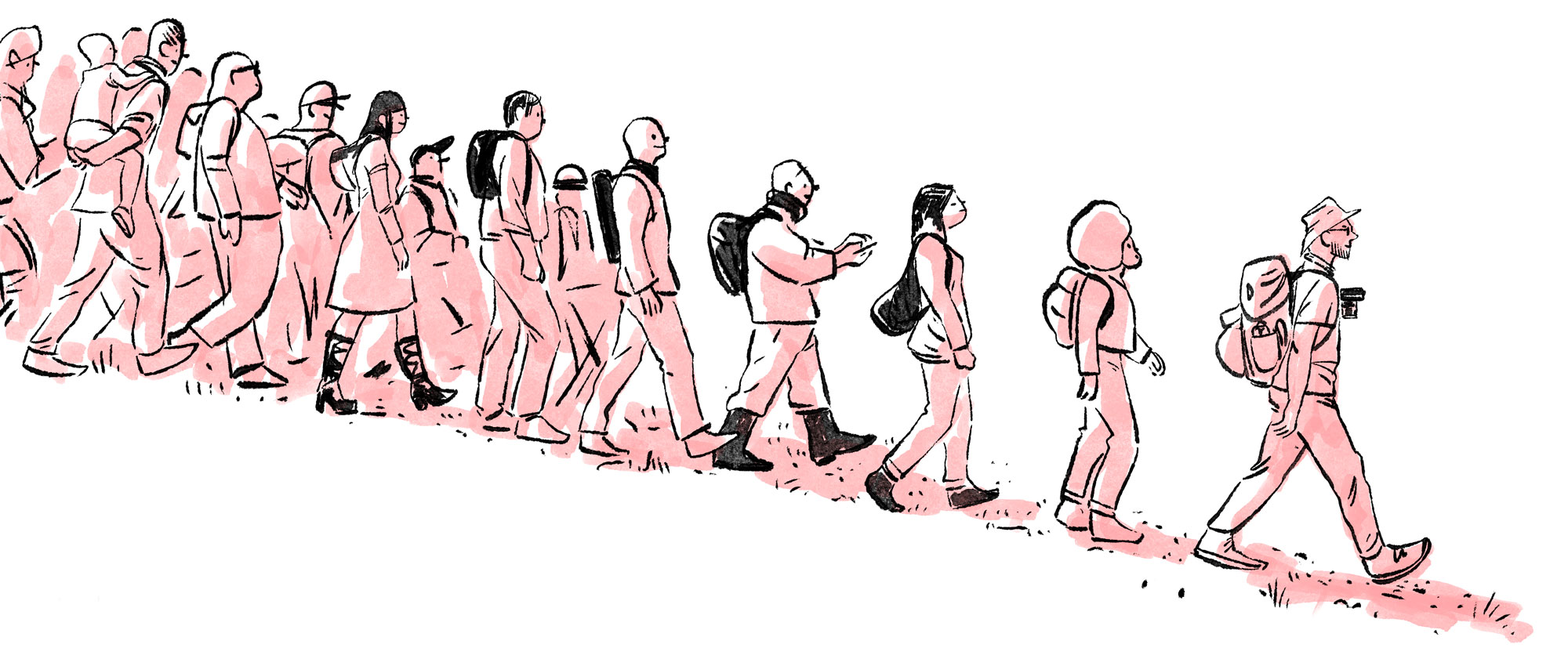
#Noted
-
But also these old gatekeeper systems do kinda stink (that’s what’s exciting about the autonomy brought about by the internet, by accessible payments systems, by membership programs!). Try not to get too down if you run into the walls of these old systems. I’ve run into them and continue to run into them, and they still bum me out. ↩︎
-
Which I mention only in that it acutely affected my ability to work for several months (and I’d categorize it as a major life event); sickness and sadness are part and parcel of any life well-lived, and should be accounted for when running a membership program. Sometimes you need to take some time off, and you need to believe your members will understand. ↩︎
-
He writes, knowing that in writing this, he has cursed himself, and that indeed, the must be more errata in this 4th edition, meaning only one thing: the 5th edition will be perfect. ↩︎
-
This does mean that folks can “leak” the urls of these videos. That’s fine. There is a balance to be had between creating meaningful friction, and maniacally obsessing over “piracy.” I trust that members will know not to leak or share things (if they do, I can always take the video down). Same goes for my hacked together .htpassword members-only area. Everyone has the same login. Again, I can change it. I don’t want to spend time helping members remember their logins. I want to establish simple friction but high value-exchange in the space between non-members and members. And I want to spend as little of my time as possible maintaining it! ↩︎
-
The reason being: They’re all written by the seat of my pants, and as such — while fun in the moment — maybe not exactly what I want to have hanging out at a public URL? They are the grist for future books, and in that way they are drafts. I offer the archives to members as an educational feature more than a way to artificially limit access. And by knowing the archives will be somewhat “hidden,” I am able to write more freely in the moment. ↩︎
-
Although also weirdly bespoke? Like, Ecamm’s interface is all custom components. Albeit good ones. But I miss some of the more “power user” features and functions of OBS. OBS is sort of like the Linux of livestreaming and is truly impressive, incredible software. But overall, Ecamm removes a little bit of friction for doing livestreams, is a tad more “reliable,” and that alone is value enough to justify the switch. ↩︎
-
Of course, there’s also rent for my studio, Studio Manager costs, and productions costs for books and prints, all of which vary depending on the week / month / year. ↩︎
-
Campaign Monitor (newsletter software) comprises roughly 40% of all costs ($300/mo!!), but it is also the biggest driver of sales / distribution. My Campaign Monitors flows are also all so complex, and know how the system works (I’ve been using it for almost twenty years!), that the psychic cost of switching would also be non-trivial. On other fronts, I could also chop off a few, dumb, old domain names and save a few hundred dollars each year. But that would require me to be honest with myself, and kill the dreams of what those URLs could be. ↩︎
